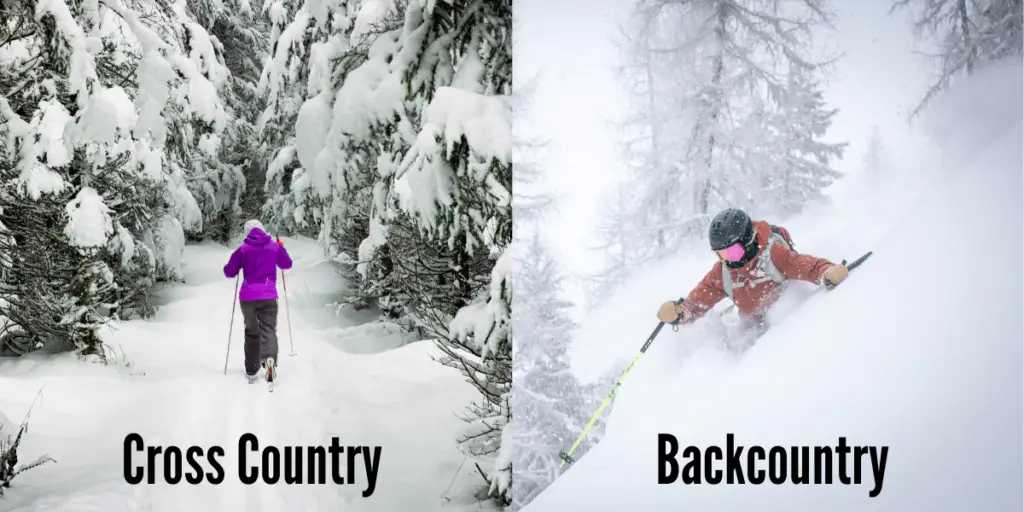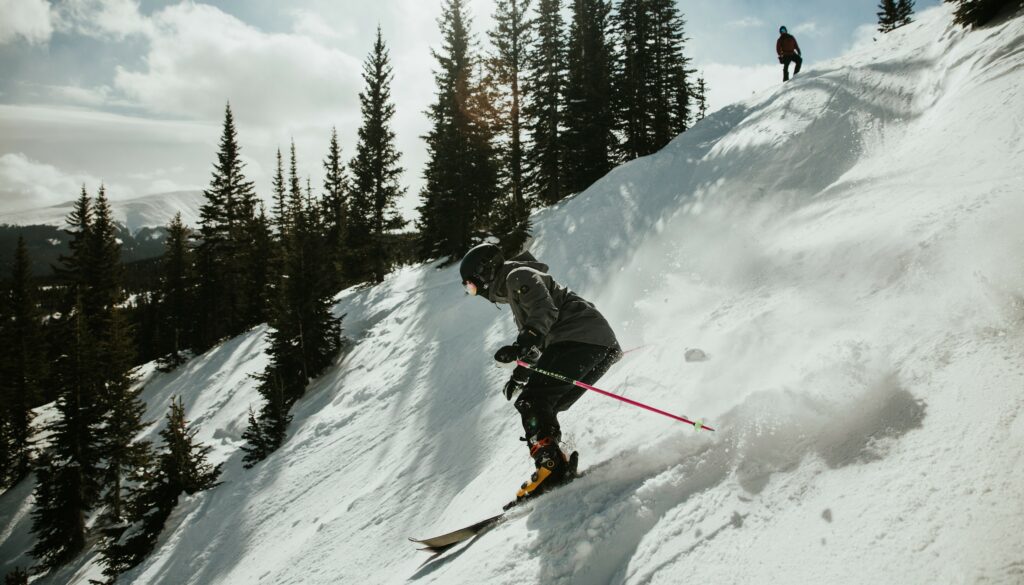There are many types of skiing, the most popular being:
- Downhill (alpine/ on-piste skiing)
- Backcountry (off-piste)
- Cross-country (Nordic)
Backcountry and cross-country skiing are often confused with one another, but there are several differences between these two types.
Cross-Country vs Backcountry Skiing
Backcountry skiing is a type of cross-country skiing that is performed on ungroomed, unpatrolled terrain. Both types of skiing involve using only the skis and poles to move across the terrain without using ski lifts, however most cross-country skiing is typically performed on groomed terrain.
| Cross-Country Skiing | Backcountry Skiing |
| Usually on groomed terrain | On unpatrolled, ungroomed terrain |
| Suitable for all abilities | Only suitable for experts |
| Requires basic training | Requires a guide and additional avalanche/safety training |

Cross-Country Skiing 101
Cross-country skiing is also often referred to as Nordic skiing. It is typically performed on flat, rolling landscapes and not on a harsh decline like with downhill (alpine) skiing. Cross-country skiing is generally performed on groom trails and involves the skier exploring the terrain without using ski lifts.
In terms of the equipment, cross-country skiing requires lightweight boots which have a “free heel” meaning they are only attached to the ski at the toe. This allows the skier to go uphill and on flat terrain, as well as downhill.
There are two styles of cross-country skiing:
- Classic: the skis run parallel to each other
- Skate: the skis are worked in a V-shape
Check out this video to see a comparison between classic and skate cross-country skiing.
Backcountry Skiing 101
Backcountry skiing is also referred to as off-piste skiing and is done outside the patrolled ski area on ungroomed terrain. Backcountry skiing is often considered as a type of cross-country skiing, since you do not use ski lifts, however cross-country skiing is primarily done on groomed trails.
Backcountry skiing is great if you love powder conditions and don’t like crowds, as the backcountry will be much quieter than the patrolled areas of the resort.
However, backcountry skiing is definitely a more extreme form of skiing with more risks. The area is not patrolled so there isn’t any help nearby outside of your group. There are also no avalanche safety checks performed in the backcountry so the avalanche risk of much greater.
This is why backcountry skiing is only suitable for expert-level skiers who have been educated on this type of skiing. It is also important to go with a guide.

Comparing the Differences
The main difference between the two types of skiing is that backcountry skiing is performed on ungroomed and unpatrolled terrain whereas cross-country skiing is primarily performed on groomed and patrolled terrain. This means there are different practical considerations to make.
Risks and Education
Backcountry skiing should only be done by expert-level skiers who have been educated and trained to backcountry ski. It should be done with an experienced guide. This is because there is a risk of encountering an avalanche in the backcountry, and the area is not patrolled so you are completely responsible for your own safety.
Most cross-country skiing is performed on groomed cross-country trails within the boundaries of the resort. Although there are definitely still risks involved, it is not considered as dangerous as skiing in the backcountry since the areas are patrolled.
Types of Skis
There are two main types of cross-country skis: classic and skating. These are designed for either style of cross-country skiing. Classic skis are longer and thinner than skate skis and have a grip zone. Backcountry skis also vary considerably in terms of their features, however they are usually wider to allow them to float more in powder.
Other Equipment
Backcountry skiing requires more essential equipment including:
- A beacon for each member of group to help locate each other in the event of an avalanche
- A probe to help find someone in the snow
- A shovel and snow saw to help check the snow condition
- A map
- First aid supplies, snacks, water, headlamp/ flashlight
Here are some more articles you might find useful.

